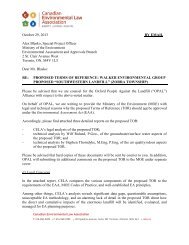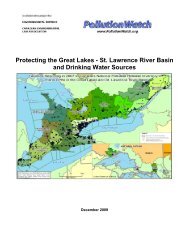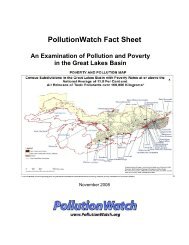H2Ontario - Version 2.0 - POLIS Water Sustainability Project
H2Ontario - Version 2.0 - POLIS Water Sustainability Project
H2Ontario - Version 2.0 - POLIS Water Sustainability Project
- No tags were found...
You also want an ePaper? Increase the reach of your titles
YUMPU automatically turns print PDFs into web optimized ePapers that Google loves.
Create a Culture of Conservationcommunities will be embedded in our economy. But until this transformation penetrates our valuesystems and infuses the market, our leaders must initiate and guide this transition.MetersMetering water use is one of the most important BMPs for encouraging water conservation, and isessential for the adoption of any volume-based pricing structure. 37 The City of Calgary has observedthrough local studies “that metered customers use 60 per cent less water on average than customerson a flat rate because they are more conscious of where and how water is used”. 38 Nationally, a similartrend has been noted. Without metering, it is impossible to understand how much water is being usedand where the opportunities for savings lie. xiiAction 19: Mandate MetersMeters should be required in all new construction of homes, businesses and industry, through:• Mandating universal metering for all urban communities.• Requiring sub-metering for multi-residential buildings.• Encouraging metering in small communities, with financial and technical support provided as needed.Full-Cost and Volume-Based PricingOntario’s Financial Plans Regulation encourages municipalities to introduce full-cost pricing. Financialplans are required by December 2010 at the latest, depending on the municipality, and will outline thefull-costs associated with providing water. There are a large number of municipalities (low-income,small, northern, and First Nations) who may be unable to fully recover the costs of municipal waterinfrastructure and operation for a number of reasons. Special consideration would need to be given tothese municipalities. The intent of pricing water according to its full cost is to move away from aculture of “cheap water” in areas where residents can currently “afford” to waste water.The full cost analysis should extend to protecting the source, replacing aging infrastructure at areasonable rate, water conservation planning and programming, education, research, and treatment ofwastewater as opposed to a narrow focus on water treatment infrastructure. Full-cost, volume-basedwater pricing remains a key recommendation from the Environmental Commissioner of Ontario. TheProvince should aim to continue to move towards this goal, whilst avoiding undue hardship on lowincomecommunities. In particular, equitable access should be addressed by providing the first block ofwater at low or no cost to all consumers to ensure basic human water needs are met.xiiThe PTTW allowance for reporting pump records for small self-supplied license holders, such as small agriculturaloperations, is a reasonable approach to avoid a cost burden on rural families.<strong>H2Ontario</strong>: A Blueprint for a Comprehensive - 28 -<strong>Water</strong> Conservation & Efficiency Strategy
















